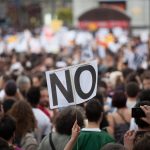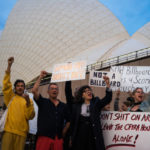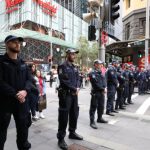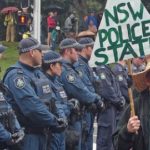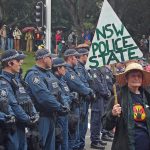Encroachments Upon the Right to Protest: An Interview With RAC’s Dr Nicholas Riemer
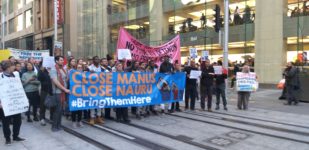
There was a large turnout at Sydney’s Town Hall on 20 July to protest the fact that the Australian government has now detained asylum seekers and refugees on Manus and Nauru for six years. Indeed, Morrison and his cronies continue to incarcerate over 800 innocent people offshore.
The speakers addressing the crowd spoke about Australians being complicit in this brutality, how locking up innocent people to have as examples amounts to slavery, and they lamented the loss of a functioning opposition, as federal Labor has curled up in the corner and gone to sleep.
The Refugee Action Coalition (RAC) organised the demonstration. And a few days prior to the Six Years Too Long rally, the group announced that “in a further crack down on civil liberties”, NSW police had denied the human rights march permission to make its way through the Pitt Street Mall.
In addressing the demonstrators prior to the march, Dr Nicholas Riemer, a RAC spokesperson, said the prohibition was basically “an attack on the right to protest”, as the authorities were denying the message about offshore detention being conveyed in the most crowded of CBD thoroughfares.
Slow drip erosion
But, this is not the first attempt by NSW authorities to silence the voice of dissent. Rather it’s part of the Liberal National government’s ongoing program of incrementally stripping away citizens’ rights to protest in this state.
The Inclosed Lands Amendment Bill was passed by the Baird government in March 2016. It created a new unlawful entry offence, which entailed a tenfold increase in penalties. And it also broadened which forms of industry an individual can be sent to prison for obstructing.
The Crown Land Management Regulation 2018 took effect on 1 July last year. It continued to provide authorities with the powers to prohibit the right to protest – or even gather, meet or assemble – on over 40 percent of the land in this state. And the Coalition upped the penalties that apply.
While just last week, the Berejiklian government announced new ag-gag laws that will see animal rights activists that trespass on agricultural land being issued with $1,000 on-the-spot fines, as well as fines of up to $220,000 for individual trespassers who find themselves in court.
Silencing dissent
“Fundamental freedoms, like the right to protest, are eroded gradually,” Dr Riemer told the protest crowd, “just like we’re seeing here.” But, this was not the first time the Sydney University English and linguistics lecturer has seen the local police hinder a specific protest.
Back in 2014, the NSW police prevented a BDS group from protesting out the front of a Sydney Israeli film festival. The protesters, which included the doctor, wanted to draw attention to the rising death toll of the war in Gaza, yet NSW authorities silenced them.
Sydney Criminal Lawyers spoke to Dr Nicholas Riemer about what was really behind the police preventing the recent protest from marching through the mall, the broader shift towards authoritarianism that this is all a part of and how the right to protest needs to be defended.
Firstly, Dr Riemer, what was the significance of the Sydney “Six Years Too Long” refugee protest that RAC organised a few weeks back?
It was to mark six years of asylum seekers being imprisoned and tortured by the Australian state on Manus and Nauru. And particularly, in the context of the re-election of the Liberal government and the threat to the Medevac legislation, which the government has said it wants to repeal.
The demonstration was there to call for an end to offshore processing. And for all the refugees offshore to be brought to Australia.
We had a larger turn out than we anticipated, not just in Sydney, but in other places as well. And that speaks to the degree of anger that there is in the community about the way that refugees continue to be abused by both sides of politics.
The protest was originally going to make its way through the Pitt Street Mall. Why was that of importance?
That’s a traditional route for protest marches in Sydney. And it has been for many years. Pitt Street Mall is a pedestrian area, so there is no disruption to traffic involved. And because there are people milling there, it gives the protest a particularly high degree of visibility.
We don’t always march through the Pitt Street Mall, but we quite regularly do. And not just Refugee Action Coalition marches, grassroots activist groups from a wide variety of causes that regularly hold demonstrations in the city use the Pitt Street Mall.
This is precisely because it is the highest visibility public space in the CBD. So, for the police to suddenly decide that marches of a certain size are no longer allowed there, that’s a very significant constraint on the right to protest effectively in Sydney.
Was the size of the protest the main reason NSW police gave for not allowing the march to go through the mall?
Well, you don’t need to apply for permission to hold a protest in NSW. But, unless you notify the police of the location and time seven days beforehand – by putting in a Form 1 – the protesters themselves risk fines for obstructing traffic and other similar offences.
The procedure you go through with the police is not to ask for permission for the protest to happen, it’s to prevent there being any risk to protesters.
That might seem like a slender distinction. But, its fairly important to insist on, because it recognises that there should be a right to protest that’s automatically granted, which is an important facet of a democratic state.
We notified the police within that seven day timeframe. They got back to us saying they had concerns about marchers of over 500 people using the Pitt Street Mall.
They specified that they didn’t intend to impose any type of permanent ban on the use of the Pitt Street Mall. But, when there were marchers of over a certain size – 500 people – they thought there were safety concerns about the presence of those kinds of numbers in the mall.
But, it’s striking that it’s only a protest group that gets singled out. Pitt Street Mall regularly sees a very large amount of foot traffic for retail purposes. If you have ever been through there on a weekend, you know that often space is quite tight, because of the crowds that gather around the buskers that regularly perform there.
And if you go on the internet, you can see historical photos of very large crowds in Pitt Street Mall. Certainly, far more than the 1,500 people that we had that would have been spread through the entire mall. So, this seemed very unconvincing to us.
What did you feel was more so behind it?
This is an instance of police intimidation toward left-wing protesters. It’s as simple as that.
Our negotiations were with the uniformed police. But, on the day of the march, everybody was surprised to see a very large number of riot and mounted police blockading either end of the Pitt Street Mall, in a particularly threatening and intimidatory way.
The political message – both to the protesters and onlookers – is very clear. It’s that NSW police opposes a human rights march in the centre of the city, in a context where the police have come under a lot of justifiable criticism for strip searches among other things.
And we should read this as an assertion of the determination of the NSW police to assert themselves in a heavy-handed way even if that comes at the expense of democratic liberties.
You stated during a speech you gave at the protest that this decision by police was an attack on civil liberties. Can you elaborate on that?
It clearly was. The police made it very clear that they weren’t interested in any kind of negotiations that might have addressed the safety concerns they had.
We would have been entirely ready to talk to them about how the march could have gone through the Pitt Street Mall in a way that would have reduced the number of people in there at any time.
For example, we would have been open to marching through the mall at four or five abreast at most, to make sure there was plenty of space on either side of us. We were quite prepared to negotiate with police. It was very clear from the start that their agenda was simply to ban the use of the mall.
And that failure to negotiate indicates a lack of sympathy for the idea that a protest group should be able to stage a political demonstration on the terms that it sees fit.
The police started from the presupposition that the right thing to do was to just block, interfere and obstruct the protest march.
Obviously, they offered us an alternative. And on this occasion, they didn’t prevent us from marching at all. But, it concerns me that the rationale that they gave for not using the Pitt Street Mall was so flimsy.
If it was upheld in the courts it would give them a precedent to basically invoke spurious safety concerns at any point in the future if they didn’t like the idea of having to facilitate a march anywhere in the city, not just the Pitt Street Mall.
This is a dangerous precedent. And the idea that buskers are more important than people from the community expressing an opinion on a human rights issue is an extremely unfortunate situation.
The NSW government has been cracking down on protests over recent years. How would you sum up what’s been going on in this state in regard to protest laws?
I don’t think there’s any doubt that there’s an increasing authoritarianism in Australian political life. And this isn’t just in Australia, it’s in the West. Protest groups are among the principal victims of it.
It’s obviously not just protest groups. The recent crackdown we’ve seen on journalists and whistleblowers is another very clear example.
Dutton’s bid to extend the government’s surveillance powers is another example of a very worrying anti-democratic trend, which typically has not been opposed by the ALP. So, we have a bipartisan situation. I’m specifically thinking of the bids to increase state security powers and surveillance powers. The opposition is missing in action on these questions.
It’s part of a tightening of the state’s repressive apparatus. It’s highly undemocratic and very worrying.
And lastly, Dr Riemer, where do you see this all heading? How should the right to protest in this state be defended?
The principal way is for there to be very large protests of the kind that we saw during the equal marriage debate and most recently, during the school climate strike. That’s the fundamental key to reasserting the right to protest in NSW.
In the current situation, there’s no way that we will not end up in court at some point in the medium term the next time police try to prevent us from marching through Pitt Street Mall or somewhere else. That’s the immediate legal front.
But, in terms of the long-term solution, the real way to prevent the right to protest being encroached upon is for people to come and demonstrate in very large numbers.


